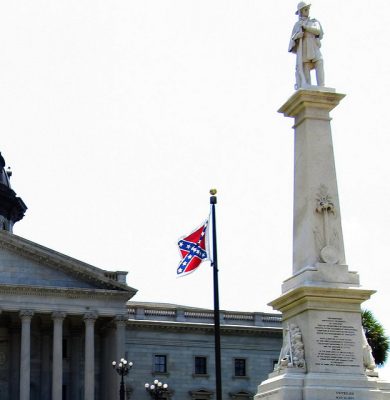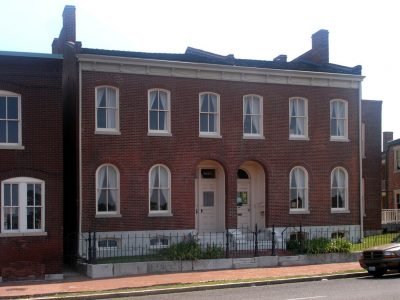Teaching uncomfortable narratives in public history courses
27 September 2017 – Jennifer Black
Editor’s note: The post is the second in a series commissioned by The Public Historian that focuses on essays published in TPH that have been used effectively in the classroom. We welcome comments and further suggestions! If you have a TPH article that is a favorite in your classroom, please let us know. You can send your suggestions to [email protected].

Confederate Battle Flag flying at South Carolina’s State Capitol in Columbia, June 2011. The legislature removed the flag in July 2015. Photo credit: Ken Lund, CC BY-SA 2.0.
Two summers ago, as I finalized my Introduction to Public History syllabus for the upcoming fall semester, I chatted with a colleague about my desire to incorporate more discussions of politics and memory into the course. My colleague asked, “Are you going to talk about the flag?”
That was the summer of 2015, about a month after Dylann Roof entered the Mother Emanuel AME Church in Charleston, SC, and senselessly killed nine peaceful churchgoers as they prayed. After photographs of Roof posing with the Confederate flag surfaced online (along with his hate-filled manifesto outlining his intentions to start a “race war”), a national debate engulfed the nation about the place of the Confederate flag in contemporary society. From those who saw the flag as a symbol of white supremacy—evoking the Civil War, the 1948 Dixicrats, and George Wallace’s segregationist rhetoric in the 1960s—came the call to “take it down.” From the defenders of the flag came an alternate view, that the flag represented “heritage, not hate.”
I decided my colleague was right: how could I teach a course about the role of public historians in contemporary society without acknowledging the current drama over historical memory that had unfolded? As I set to work revising my syllabus, I searched for readings that could appropriately set up public investment in the telling of history, while outlining the role of public historians in framing that narrative. I selected an article on Civil War reenactors as a lead-in to our discussion of the current flag debates, and the article by Timothy Baumann, Andrew Hurley, Valerie Altizer, and Victoria Love, “Interpreting Uncomfortable History at the Scott Joplin State Historic Site in Saint Louis, Missouri” (The Public Historian 33, no. 2 (2011): 37–66), as a bookend to the discussion.
Baumann et al.’s article presents a case study of the first African American historic site to be included in the Missouri State Park system. In this capacity, the Scott Joplin House bore an important responsibility for representing African American history, and, in its initial presentation, offered a rather sanitized story of Joplin’s life. Yet during a site reinterpretation in the early 2000s, newly discovered archaeological evidence revealed a potentially unsettling counternarrative, one that traced Joplin’s life as a poor, struggling musician living in a segregated urban community in the early twentieth century. Undertaking an approach rooted in community-based research, the authors sought to better understand the concerns of the local community and tell a story that was more authentic in terms of the urban African American experience circa 1900, but which also carried the story forward to organized neighborhood protests and activism in the mid-twentieth century.

Scott Joplin Historic Site, St. Louis, Missouri. Photo credit: Kevin Saff, CC BY-SA 2.
In this restructuring, the reinterpretation committee emphasized the larger context of race relations and political developments to balance the “unpleasant depictions of neighborhood life”—such as the proximity of brothels to Joplin’s flat and Joplin’s own death from syphilis—with more “uplifting stories of organized struggle” (54). But the historians involved also took the opportunity presented by these unsavory details to use the site as an educational resource that would address contemporary issues pertinent to the community, such as domestic violence, women’s issues, and STDs. By fostering “frank and open dialogue among museum professionals, scholars, and local residents,” the historians involved in the Joplin House reinterpretation sought to connect Joplin’s story and historical context to the challenges that continue to face the community, and thus provide a model for using public history to promote social activism (65). By illuminating the ways that “uncomfortable issues” in the past—such as poverty, prostitution, and segregation—continue to affect the present, “history and historic sites can then become agents of democracy” to motivate contemporary civic engagement and revitalize communities (39).
This article provided several methodological and theoretical discussion points that proved instructive for my students. First, the authors emphasize the idea that historic sites are not static places frozen in time, but rather living environments whose historical evidence and narratives can—and should—be continually updated to reflect the context of the past and the concerns of the present. This requires periodically searching for new archaeological, oral, and material evidence and incorporating such evidence into reinterpretations of the site. Second, the authors insist upon incorporating community voices into the construction and interpretation of historic sites. As they demonstrate with their case study, connecting historic sites to their communities means embracing the changing demographics, needs, and concerns of community residents while remaining true to historical context and evidence. This methodological model thus introduces students to the concepts of shared authority and community-centered research, which in turn emphasize the importance of civic engagement through public history. Finally, the piece carves out a clear activist role for public historians that is both true to the historical record and cognizant of the challenges facing contemporary communities. The authors suggest that history can be used to both educate and motivate the public to pursue social change.
Assigning this article in the week following our discussion of the Confederate flag controversy achieved several goals. First, the piece introduced many of the socioeconomic issues that underscore the Black Lives Matter movement (which my students saw as intimately connected to the debates over the Confederate flag), including lingering racial tensions and urban poverty. The article historicized these issues in a way that helped the students see the legacies of the Jim Crow era in contemporary society. More importantly, the article pushed my students to articulate the role—and the responsibility—of public historians in contemporary society. Should historians be passive documenters and storytellers, simply conveying information, or can they articulate arguments that use the past to push for change? After our discussion of the flag, my students were deeply divided over whether public historians ought to simply “tell the truth” and present the facts, or whether historians have license to challenge prevailing narratives with unpopular and perhaps unsettling evidence, perhaps creating “spin” that rewrites the narratives altogether. The discussion provided by Baumann et al. unraveled that position a bit, by demonstrating that such reinterpretation is likely to be both politically challenging and ethically necessary. Competing demands from constituents and changing political climates can influence the relative popularity of reinterpretation efforts, but, as the authors suggest, public historians bear a responsibility to the communities they represent: if we recognize social injustices of the past and truly want to educate the public, we ought to acknowledge the legacy of such injustices with the goal of promoting social change. In short, the piece gave my students a model for how public historians might use the past to influence a better future.
~ Jennifer Black is a historian of visual and material culture, with a particular focus on the late nineteenth and early twentieth centuries in the United States. In addition to teaching a variety of courses in American history, public history, and visual culture at Misericordia University, she is also network editor-in-chief of H-Material Culture. She can be found online at http://jennifermblack.org/, and on Twitter @blackjen1.




I like the idea of interpreting uncomfortable history in the context of current events. For over 20 years I served with the Community Relations Service an small agency within the USDOJ whose essential mission is to help local communities resolve various levels of racial division and tensions such as those that took place in Ferguson, MO and in Charlottesville, VA. etc. by initiating public and private dialogues between disputing factions. We styled ourselves as “The Nation’s Peacemakers.” In my personal experience over the years I talked to people who represented both side of the conflict and time after time the discussions often returned to the historical background of the current conflict which had its beginnings many, many years before it erupted. But, for the most part these histories of community conflict were known only to a few and unknown to most residents and fewer officials. Clearly cases of George Santayana’s maxim that ” those who cannot remember the past are condemned to repeat it.” A After a while I also realized that as a general rule these disruptions which ranged from conventional, run of the mill sit ins, marches etc to outright riots were cyclical in nature and occurred roughly every ten -20 years apart.in the US .Anyway in 2017 long after my retirement i decided to look into the forgotten history of riots in New York State in the 18th and 19th century and the newyorkhistoryblog.org published them as a series, beginning with“The New York Slave Conspiracy Riot of 1741” and ending with ” Orange Riots of 1870 and 1871 in New York City.
In most riot affected communities, residents and authorities perceive the rioting from an isolated, local perspective and treated almost like a family embarrassment that is not spoken of in polite circumstances. In many instances, this approach has led to denial and forgetting. Regardless, these violent times in local communities need to be put in the context of the broad sweep of national history and come out of the closet as it were, to serves as reminders of the work that still has to be done for America to live up to its promise of racial justice and equality before the law.